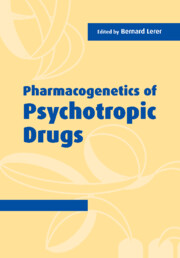Book contents
- Frontmatter
- Contents
- List of contributors
- Part I Introduction
- Part II Clinical background and research design
- Part III Molecular background
- Part IV Pharmacokinetics
- 8 Pharmacogenetics of psychotropic drug metabolism
- 9 Pharmacogenetics of chiral psychotropic drugs
- Part V Specific psychotropic drugs and disorders
- Part VI Pharmacogenetics and brain imaging
- Part VII Industry perspectives
- Index
8 - Pharmacogenetics of psychotropic drug metabolism
from Part IV - Pharmacokinetics
Published online by Cambridge University Press: 20 August 2009
- Frontmatter
- Contents
- List of contributors
- Part I Introduction
- Part II Clinical background and research design
- Part III Molecular background
- Part IV Pharmacokinetics
- 8 Pharmacogenetics of psychotropic drug metabolism
- 9 Pharmacogenetics of chiral psychotropic drugs
- Part V Specific psychotropic drugs and disorders
- Part VI Pharmacogenetics and brain imaging
- Part VII Industry perspectives
- Index
Summary
OVERVIEW
Drug metabolism is a critical determinant of therapeutic and adverse effects of many psychotropic drugs. Research since the 1960s has firmly established that genetic factors play a prominent role in marked person-to-person variability in drug metabolism. Pharmacogenetics is the study of the hereditary basis of individual differences in drug response. The present chapter reviews the basic concepts and definitions pertinent to pharmacogenetics of psychotropic drug metabolism from a clinical psychiatry perspective. The focus of pharmacogenetic investigations has traditionally been unusual and extreme drug metabolism phenotypes resulting from a single gene effect. To this end, we discuss the CYP2D6 genetic polymorphism as a classic example of a monogenic variation in drug metabolism and as a high-affinity and low-capacity elimination route. This is contrasted with CYP1A2, a nonpolymorphic variation in drug metabolism under polygenic control. In addition to genetic contribution to interindividual differences in drug metabolism, we review various sources of intraindividual variations and gene–environment interactions of relevance for psychopharmacology. For example, we describe the extent and mechanistic basis of drug and nutraceutical (e.g., St. John's wort) interactions and disease influences (e.g., human immunodeficiency virus (HIV) infection) on drug metabolism. Lastly, we highlight some of the future research directions in psychotropic drug metabolism. In particular, we emphasize the need to evaluate genetic variability in drug metabolism in conjunction with other genes encoding drug transporters, receptors and ion channels, which can all influence an individual's risk for adverse drug reactions or therapeutic failure.
Keywords
- Type
- Chapter
- Information
- Pharmacogenetics of Psychotropic Drugs , pp. 157 - 180Publisher: Cambridge University PressPrint publication year: 2002
- 2
- Cited by

